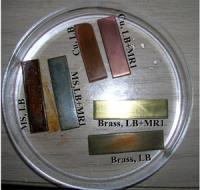
Exposed metal surfaces are highly vulnerable to corrosion, but paint or other protective coatings can interfere with some uses, as well as add significant costs. Now, a comprehensive series of experiments suggests a new form of protection: bacteria.
Researchers at the Corrosion and Environmental Effects Laboratory of (CEEL) USC Viterbi School have been working on analyzing the ability of an organism called Shewanella oneidensis MR-1 (hereinafter MR-1) to protect a number of metals.
The director of CEEL Prof. Florian Mansfeld and PhD candidate Esra Kus have been collaborating with Prof. Ken Nealson of Department of Earth Sciences. The team made a preliminary presentation at a Denver conference last month, and will make a more detailed one in Mexico in October.
The concept of Microbiologically Influenced Corrosion Inhibition has been discussed in the scientific literature since 1997. Researchers at the University of Connecticut, University of Southern California and the University of California at Irvine had reported corrosion inhibition in their earlier studies by means other organisms and regenerative biofilms.
In a study in 2001 Mansfeld and Nagiub reported microbiologically influenced corrosion inhibition for Al2024, mild steel, cartridge brass and stainless steel when bacteria contaminated an artificial seawater solution containing growth medium. They also showed that a bacterium of the same genus as MR-1, S. algae, prevented pitting of aluminum and some steel.
MR-1, first discovered by USC Professor Ken Nealson of the USC department of Earth Sciences, who is a co-author on the study is a remarkable organism that can incorporate metal into its metabolism, "inhaling certain metal oxides and compounds in one form, exhaling them in another," according to Denver presentation. MR-1 has previously been used to precipitate uranium out of contaminated water. And "it can grow almost anywhere and does not cause disease in humans or animals," they note.
And it can protect metal.
The experiment performed at CEEL was simple. Matched pairs of samples of five metals — aluminum 2024, zinc, mild steel, copper, and brass — were prepared. One sample set of each pair was incubated in a growth medium containing MR-1; the other in a sterile bath of the same growth medium, containing neither MR-1 nor any other organism.
After a week, corrosion was monitored, both visually and by measuring electrochemical impedance (resistance to conducting alternating current.) Because electrical effects play a role in many forms of corrosion, higher AC impedance is associated with increased corrosion resistance.
The results were clear-cut. For all the materials, impedance increased with exposure to bacteria, and the longer the metals were exposed, the more resistant they became. The increase was particularly marked in the aluminum samples. By the end of the week the control samples showed obvious visual pitting, while the ones with MR-1 colonies were unscathed.
The pattern of impedance varied from metal to metal. Aluminum showed drastic reduction in resistance to electrical currents in all frequencies. Brass and, particularly copper showed nearly as dramatic an effect — readings indicated active corrosion in the control samples, but a large reduction in the MR-1 samples. The copper MR-1 samples, in fact, showed a profile similar to that demonstrated by copper covered with a protective polymer plastic film.
The patterns for steel and zinc were much less marked, but still significant, as was the difference in the metals' appearance.
The next step, according to Mansfeld, is to figure out exactly what is going on and determine where and how the presence of bacteria is altering the corrosion equation. To do this, the group will be making molecular scale analysis of bacteria/metal interfaces, and looking to determine what the properties of MR-1 biofilm are, as well as why the pattern of interaction differs from metal to metal.
While MR-1 itself may not be the metal protector of the future, it may well suggest an agent that can be, Mansfeld says. The research will be presented at the 210th Meeting of the Electrochemical Society in Cancun, Mexico | October 29-November 3, 2006.
Source : University of Southern California
 Print Article
Print Article Mail to a Friend
Mail to a Friend
